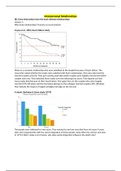Samenvatting
Summary Interpersonal Relationships: book and lectures
- Instelling
- Radboud Universiteit Nijmegen (RU)
. Summary from the course "Interpersonal Relationships" at the Radboud University. Everything you need for the exam: a summary of the book "Intimate Relationships" by Miller and all the information from the lectures from Johan Karreman, including screenshots of the studies he talked about.
[Meer zien]






